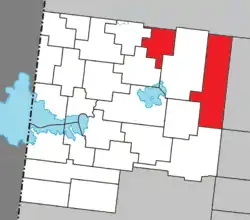Rivière-Ojima
Rivière-Ojima is an unorganized territory in the Abitibi-Témiscamingue region of Quebec, Canada. It consists of two non-contiguous areas in the Abitibi-Ouest Regional County Municipality, separated by the municipality of Authier-Nord. The communities of Languedoc (48°48′26″N 78°41′48″W) and Saint-Eugène-de-Chazel (48°57′06″N 78°58′38″W) are located within its boundaries.
Rivière-Ojima | |
|---|---|
 Location within Abitibi-Ouest RCM. | |
 Rivière-Ojima Location in western Quebec. | |
| Coordinates: 48°50′N 78°42′W[1] | |
| Country | Canada |
| Province | Quebec |
| Region | Abitibi-Témiscamingue |
| RCM | Abitibi-Ouest |
| Constituted | January 1, 1986 |
| Government | |
| • Federal riding | Abitibi—Témiscamingue |
| • Prov. riding | Abitibi-Ouest |
| Area | |
| • Total | 356.20 km2 (137.53 sq mi) |
| • Land | 356.04 km2 (137.47 sq mi) |
| Population (2011)[3] | |
| • Total | 104 |
| • Density | 0.3/km2 (0.8/sq mi) |
| • Pop 2006-2011 | |
| • Dwellings | 51 |
| Time zone | UTC−05:00 (EST) |
| • Summer (DST) | UTC−04:00 (EDT) |
| Highways | No major routes |
Founded in 1949, Languedoc is the youngest rural population centre of the Abitibi and named after a region in southern France. The Parish of Saint-Etienne-de-Languedoc was formed in 1952.[4]
Demographics
Population
| Canada census – Rivière-Ojima community profile | |||
|---|---|---|---|
| 2011 | 2006 | ||
| Population: | 104 (-17.5% from 2006) | 126 (+14.5% from 2001) | |
| Land area: | 356.04 km2 (137.47 sq mi) | 356.03 km2 (137.46 sq mi) | |
| Population density: | 0.3/km2 (0.78/sq mi) | 0.4/km2 (1.0/sq mi) | |
| Median age: | 50.6 (M: 54.5, F: 48.5) | 45.0 (M: 48.0, F: 38.5) | |
| Total private dwellings: | 51 | 53 | |
| Median household income: | $.N/A | $.N/A | |
| Notes: Income data for this area has been suppressed for data quality or confidentiality reasons. – References: 2011[3] 2006[5] earlier[6] | |||
|
|
|
Language
| Canada Census Mother Tongue - Rivière-Ojima, Quebec[7] | ||||||||||||||||||
|---|---|---|---|---|---|---|---|---|---|---|---|---|---|---|---|---|---|---|
| Census | Total | French |
English |
French & English |
Other | |||||||||||||
| Year | Responses | Count | Trend | Pop % | Count | Trend | Pop % | Count | Trend | Pop % | Count | Trend | Pop % | |||||
2011 |
100 |
100 | 100.00% | 0 | 0.00% | 0 | 0.00% | 0 | 0.00% | |||||||||
2006 |
120 |
120 | 100.00% | 0 | 0.00% | 0 | 0.00% | 0 | 0.00% | |||||||||
2001 |
115 |
115 | 100.00% | 0 | 0.00% | 0 | 0.00% | 0 | 0.00% | |||||||||
1996 |
120 |
120 | n/a | 100.00% | 0 | n/a | 0.00% | 0 | n/a | 0.00% | 0 | n/a | 0.00% | |||||
See also
References
- Reference number 149739 of the Commission de toponymie du Québec (in French)
- Geographic code 87904 in the official Répertoire des municipalités (in French)
- "2011 Community Profiles". 2011 Canadian Census. Statistics Canada. July 5, 2013. Retrieved 2014-03-30.
- "Languedoc (Village)" (in French). Commission de toponymie du Québec. Retrieved 2008-10-01.
- "2006 Community Profiles". 2006 Canadian Census. Statistics Canada. March 30, 2011. Retrieved 2014-03-30.
- "2001 Community Profiles". 2001 Canadian Census. Statistics Canada. February 17, 2012.
- Statistics Canada: 1996, 2001, 2006, 2011 census
This article is issued from Wikipedia. The text is licensed under Creative Commons - Attribution - Sharealike. Additional terms may apply for the media files.